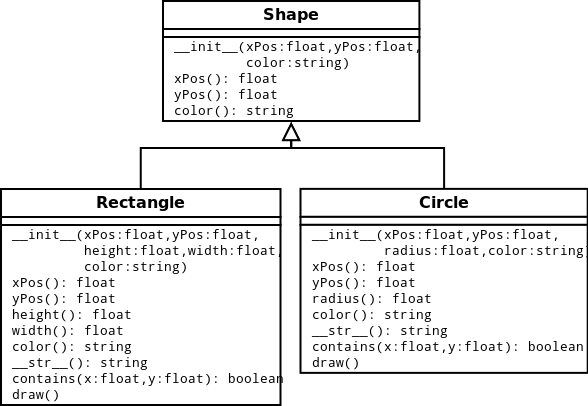In-Class Activity #3: Object Oriented Python
Objectives
The goal of today's activity is to get comfortable working with object oriented features of Python by implementing a class hierarchy.Resources
Everything you need to know to complete today's activity is covered in appendix D of our textbook. The section on Classes in the Python tutorial is also quite clear.
Exercises
- Create a new Python file, and add a
mainfunction for testing the Classes that you will create below. Don't forget to include a call tomain. - Implement the class hierarchy described by the UML diagram
below. Before you start programming, think carefully about which
data attributes and methods should be defined in which classes, and
how best to take advantage of inheritance. Test your code as you
work.

Notes:- The colons in the diagram above are used to indicate
types.
xPos(): floatindicates that thexPosmethod will return a floating point number.contains(x:float,y:float): booleanindicates that thecontainsmethod expects two floating-point parameters and returns a boolean. - Colors are represented by their names. The turtle graphics package recognizes the same set of names as the Tk package.
-
The
xPosandyPosfunctions return the of the lower-left corner of a rectangle, and the center of a circle. -
In Python it is necessary to explicitly call the constructor
of the superclass in the the constructor of the subclass. The
syntax is:
super(SubClassName,self).__init__(args)
WhereSubClassNameis the name of the subclass, andargsrepresents the arguments expected by the constructor of the superclass (excludingself). - For the time being, feel free to implement draw textually:
>>> c = Circle(0.0, 0.0, 50.0, "red") >>> c.draw() red Circle with radius 50.0 drawn at position (0.0, 0.0).
- The colons in the diagram above are used to indicate
types.
Finishing Up
There is nothing to hand in for this assignment. Make sure that you save a copy of your code, either on a thumb drive, the N: drive, or by e-mailing it to yourself. If you worked with a partner, make sure both of you get a copy.
